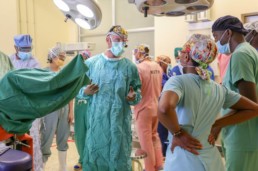
50-bed center will treat fistulas caused during obstructed labor
Amy Albin |
Fistulas are rare in developed nations where cesarean sections are available. But the World Health Organization estimates that in the east African country of Uganda about 200,000 women are living with fistulas, and that about 2,000 new cases occur annually.
But with the help of a team from UCLA Health, the new Centre for Gynecologic and Fistula Care at Mbarara Hospital in western Uganda recently opened to expand the capacity to treat this debilitating childbirth injury.
The 50-bed facility has been a long-term goal of supporters since 2009. Under the umbrella of the non-profit organization, Medicine for Humanity, Dr. Christopher Tarnay, chief of female pelvic medicine and reconstructive surgery at UCLA Health, and a team of UCLA doctors, nurses and medical students, have been traveling to Mbarara Hospital annually for two-week surgical trips to treat up to 50 women each time. During those trips, the UCLA team trained local doctors so that more women can be treated year round.
The new ward is the next step in helping create a sustainable program.
“These patients just want to be able to wake up with a dry bed,” Tarnay said. “By offering our expertise, training local doctors and now helping our Ugandan colleagues create the beautiful new space, we’ve been able to build a true center of excellence.”

The center will serve as a care and recovery center for women undergoing surgery to repair fistulas and allow them to convalesce in comfort and privacy. The existing ward had only six beds and was not big enough to handle the number of patients, some of whom had been sleeping on floors and in corridors.
Medicine for Humanity raised more than $100,000 to build the new center and helped oversee the design and construction.
Tarnay was overwhelmed when he saw the new building in person.
“To see the center completed, when just two years ago it was only a hope, was quite miraculous. It is a beautiful structure,” Tarnay said. “I got a bit emotional when went over early to see it before the ribbon cutting ceremony. I was with my wife and our foundation executive director, and we just stood in shock at what we helped build.”

